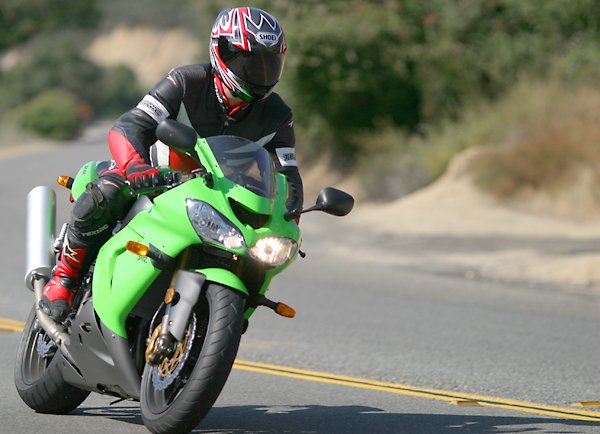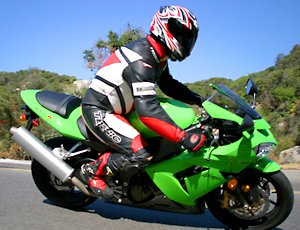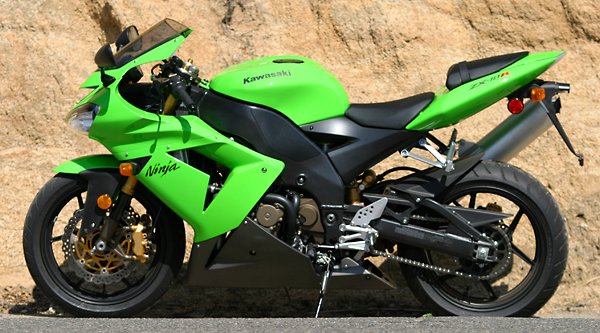
You may be wondering why we are reviewing Kawasaki’s 2005 model ZX-10R, the winner of our 1000cc sportbike comparison last year, given the fact that it is unchanged for 2005. Well, there are two reasons. First of all, the bike is not “unchanged” (see discussion below), and secondly we wanted to ride the bike alongside Suzuki’s new GSX-R1000, which was reviewed by MD earlier this month.
As a baseline for this discussion, take a look at our original test of the 2004 ZX-10R here, which discusses all of the technical specifications of the machine (specifications we won’t bore you with yet again). In summary, last year during our comparison test, we concluded that the Kawasaki ZX-10R was the lightest feeling, most nimble, most powerful stock 1000cc sportbike we have yet encountered, and awarded it first place.
That awesome motor is still attached to the Kawasaki frame this year, and the bike is largely unchanged. Take a look at our comparison test results here to see why we ranked the ZX-10R ahead of the competition.
The reason we didn’t do a formal 1000cc shoot-out this year is simple. Two of the three bikes Kawasaki defeated last year are unchanged for 2005. Only one bike is new this year, and that is the Suzuki GSX-R1000. We will tell you how we feel the ZX-10R measures up to the new GSX-R1000 later in this article.
So, what’s new with the ZX-10R for 2005? Aside from some new color choices, (we will refer you to Kawasaki’s web site where you can see those new colors), Kawasaki focused on refining the transmission and suspension for 2005.
The transmission has a long list of changes for 2005, and they add up to a very impressive gear changer. You may recall that the Kawasaki ZX-10R had some transmission issues at its initial press launch that were addressed before production models became available for the 2004 model year. Our 2004 ZX-10R worked fine in this respect, and the 2005 exhibited no transmission issues whatsoever. Shifts were smooth and positive with or without the clutch, and right on par with the excellent Suzuki GSX-R1000 transmission.

We raved about the Kawasaki’s suspension last year. If anything, we noted some minor harshness during the initial travel of both the fork and the shock. This is sometimes a necessary trade off when suspension is tuned stiffly to deal with aggressive riding. For 2005, Kawasaki made changes to both the fork and the shock to create a more plush and controlled initial travel.
The fork features shorter top-out springs and a 10mm lower oil height. The shock, meanwhile, has several changes designed to reduce friction, as well as a coil spring with reduced diameter wire, that also contributes to a more plush initial stroke. Again, these changes were a success as we will discuss in greater detail below.
The personality of the 2005 Kawasaki ZX-10R hasn’t changed. It is still aggressive, precise, and demanding of the rider’s attention. As we said last year, this machine is stiff, tight and responsive, both from an engine and a chassis standpoint. The suspension changes for 2005 have really improved things, however, doing a better job of keeping the Kawasaki tracking through small bumps, both in a straight line and through corners. Overall, the suspension still has that tight, controlled feel, but with less harshness.
Indeed, it is in the suspension area where the Kawasaki is perhaps most superior to Suzuki’s new GSX-R1000 (tested by MD here). The 2005 GSX-R1000 has excellent suspension, don’t get us wrong, but the spring rates almost feel like they belong on a sport tourer, rather than a hard core, 1000cc sportbike. The shock, in particular, tends to squat more than it should on corner exits, while hard on the gas. The Suzuki suspension makes for a comfortable ride, but it is not nearly as tight or controlled as the Kawasaki when pushed hard.
In fact, the 2005 Kawasaki ZX-10R has one of the best stock sportbike suspension set-ups we have tested. All three testers who rode the bike never touched any of the suspension settings and came away happy with the Kawasaki’s balance and feel.
Another area where the Kawasaki has an edge on the Suzuki is in the feedback department. Both bikes provide excellent chassis feedback, but the Kawasaki, perhaps due to its superior suspension, surpasses the Suzuki when it comes to telling the rider what the tires are doing at their respective contact patches.

For 2005, Suzuki takes top honors in the motor department, however. The Kawasaki ZX-10R was our torque monster last year, and it still has a very healthy low-end and mid-range power delivery (ideal for street riding) with a wicked top-end rush. The Suzuki simply has more down low and in the mid-range, however (without any advantage on top — at least as far as we can tell). As we said in our earlier ride review of the Suzuki, the new GSX-R1000 has no peers when it comes to power delivery at the lower end of the tachometer.
The ZX-10R engine, of course, is no slouch down low. We are certainly comparing two superior power plants, and the difference is really one of “excellent” versus “very, very good”.
Both of these bikes have excellent brakes, but the Kawasaki ZX-10R was our favorite in this department, both in terms of power and lever feel. The Kawasaki has more initial bite than the GSX-R1000, and probably equal power, but the Kawasaki ZX-10R’s front brake was easier to control with a more linear, progressive lever, whereas the Suzuki seemed to require more lever pressure and deliver most of its braking power in the last quarter inch, or so, of lever travel. Again, the brakes on both of these bikes are so good that this is essentially a non-issue, but the Kawasaki wins this category.
Ergonomically, the Kawasaki is the more aggressive machine. The Kawasaki remains comfortable, however, and provides a bit more leg room than the Suzuki GSX-R1000.
As far as instrumentation is concerned, Kawasaki is again let down by its absurd tachometer. Without enough contrast between the background and the LED sweep, the tach is virtually impossible to read, particularly on a bike this powerful, requiring this much rider focus. The rest of the instruments are fine (see our discussion in earlier articles).
Styling is always subjective, and we have to call this category a draw. The Kawasaki has a lean jet-fighter style that looks every bit as fresh as it did last year, while the GSX-R1000 has fresh clothes and a uniquely styled exhaust system that really grew on us.

In the end, I sat down and had a long phone conversation with one of our other principal testers and asked this question: “Which of these two bikes would you prefer to have in your garage?” The answer for both of us was Kawasaki’s ZX-10R, although it was extremely close. The new Suzuki GSX-R1000 is almost certainly the better starting point for a track bike/race bike. It is hard to argue with how quickly this bike started winning races at both the World Superbike level and the AMA Superbike level. The basic chassis goodness of the GSX-R1000 is undeniable, and its motor ranks at the top of the class.
Nevertheless, for 98% of the buyers who will use their bike primarily (if not exclusively) on the street, we thought the 2005 Kawasaki ZX-10R is the better machine. The motor is very close to the GSX-R1000, and on the street the difference is negligible. The suspension of the ZX-10R is clearly superior, and the best in the class at this point. While the Kawasaki requires that its rider pay more attention, and is a bit more sharp-edged in the handling department, this really adds up to a more fun, more rewarding machine to ride on a day-to-day basis . . . at least, from our perspective. In our book, the 2005 Kawasaki ZX-10R is still king of the open-class sportbike category.





